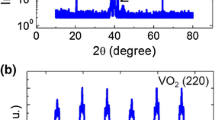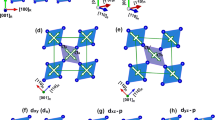Abstract
Vanadium dioxide (VO2) has tremendous potential in multifunctional device applications related to spintronics, switching, and magnetic recording. We have discovered that the room temperature ferromagnetism (RTFM) in undoped vanadium oxide epitaxial films can be switched on and off by altering the cooling ambient conditions which exhibit a sharp electrical transition at 341 K. By correlating the structural and ferromagnetic properties in VO2, we envisage the potential for creation of novel multifunctional solid-state devices. High-quality epitaxial VO2 thin films were grown on c-sapphire (0001) substrates, under different ambient conditions via the domain matching epitaxy paradigm. The observed RTFM has its origin in the valence charge defects with unpaired electrons in V+3 in VO2 thin films, where the concentration of the defects could be varied with oxygen partial pressure. The VO2 films-with a high ferro- to paramagnetic transition (Curie) temperature around 500 K estimated by fitting the magnetization data to the Bloch’s T3/2 law, a saturated magnetization of 18 emu/cm3, and with a finite coercivity of 40 Oe at 300 K-can be useful for integrated smart sensors operable at room temperature.
Access this article
We’re sorry, something doesn't seem to be working properly.
Please try refreshing the page. If that doesn't work, please contact support so we can address the problem.
Similar content being viewed by others
References
T. Yang, C. Jin, R. Aggarwal, R.J. Narayan, and J. Narayan, J. Mater. Res., 25 (2010), p. 422.
M.M. Qazilbash, M. Brehm, B. Chae, P. Ho, G.O. Andreev, B. Kim, S. Yun, A.V. Balastky, M.B. Maple, F. Keilmann, H. Kim, and D.N. Basov, Science, 318 (2007), p. 1750.
J. Nag and R.F. Haglund, Jr., J. Phys.: Condens. Matter, 20 (2008), p. 264016.
J. Narayan and V.M. Bhosle, J. Appl. Phys., 100 (2006), p. 103524.
T. Yang, R. Aggarwal, A. Gupta, H. Zhou, R.J. Narayan, and J. Narayan, J. Appl. Phys., 107 (2010)., p. 053514
T. Yang, C. Jin, H. Zhou, and J. Narayan, Appl. Phys. Lett., 97 (2010), p. 072101.
C.M. Lampert, Solar Energy Mater., 11 (1984), p. 1.
R.T. Rajendra Kumar, B. Karunagaran, D. Mangalaraj, S.K. Narayandass, P. Manoravi, M. Joseph, and V. Gopal, Sensors Actuators A, 107 (2003), p. 62.
M. Soltani, M. Chaker, E. Haddad, and R.V. Kruzelesky, J. Vac. Sci. Technol. A, 24 (2006), p. 612.
V.Yu. Zerov and V.G. Malyarov, J. Opt. Technol., 68 (2001), p. 939.
J. Narayan, Sudhakar Nori, D.K. Pandya, D.K. Avasthi and A.I. Smirnov, Appl. Phys. Lett., 93 (2008), p. 082507.
S. Mal, Sudhakar Nori, J. Narayan, and J.T. Prater, J. Mater. Res., 26 (2011), pp. 1298–1308.
S. Mal, J. Narayan, Sudhakar Nori, J.T. Prater, and D. Kumar, Solid State Commun., 150(35–36) (2010), pp. 1660–1664.
S. Mal, Sudhakar Nori, C.M. Jin, J. Narayan, S. Nellutla, A.I. Smornov and J.T. Prater, J. Appl. Phys., 108 (2010), p. 073510.
A. Tiwari, V.M. Bhosle, S. Ramachandran, Sudhakar Nori, J. Narayan, S. Budak, and A. Gupta, Appl. Phys. Lett., 88 (2006), p. 142511.
S. Ramachandran, Ashutosh Tiwari, and J. Narayan, J. Electron. Mater., 33 (2004), p. 1298.
M. Snure, D. Kumar, and A. Tiwari, JOM, 61(6) (2009), p. 72.
J. Narayan, Sudhakar Nori, S. Ramachandran, and J.T. Prater, JOM, 61(6) (2009), p, 76.
R. Lindström et al., Electrochimica Acta, 51 (2006), p. 5001.
T. Yang, S. Nori, H. Zhou, and J. Narayan, Appl. Phys. Lett., 95 (2009), p. 102506.
T. Yang, S. Mal, C. Jin, R.J. Narayan, and J. Narayan, Appl. Phys. Lett., 98 (2011), p. 091102.
T.-H. Yang, Sudhakar Nori, S. Mal, and J. Narayan, Acta Materialia, 59 (2011), p. 6362.
J. Narayan and B.C. Larson, J. Appl. Phys., 93 (2003), p. 278.
Author information
Authors and Affiliations
Corresponding author
Rights and permissions
About this article
Cite this article
Nori, S., Yang, T.H. & Narayan, J. VO2 thin films: Defect mediation in room temperature ferromagnetic switching characteristics. JOM 63, 29–33 (2011). https://doi.org/10.1007/s11837-011-0170-7
Published:
Issue Date:
DOI: https://doi.org/10.1007/s11837-011-0170-7




